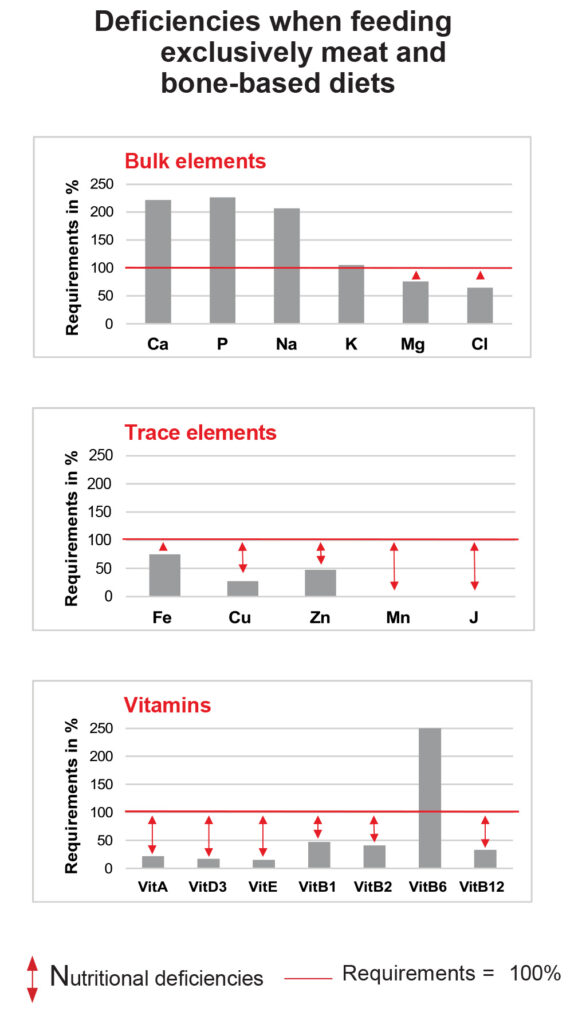An increasing number of dog and cat owners are looking for alternatives to commercial pet foods to feed their animals. The trend in recent years has been toward individually prepared meals, in which BARF diets play an important role.
This type of diet was first proposed by the Australian I. Billinghurst at the beginning of the 1990’s. He wrote a book titled “Give your dog a bone” (1993) in which he claimed that dogs have always been fed with raw meaty bones and high-grade left-overs and have been very healthy. Diseases only arose with the advent of commercial prepared pet foods. He developed the concept of BARF diets. This form of feeding pets has been growing in popularity ever since. While BARF used to take a great deal of time, there are now a wide range of ready-to-use meat mixed and prepared BARF menus available.
Definitions
The term BARF initially referred to both the dog owners that fed according to this principal as well as the diet itself. Originally, the acronym stood for “born again raw feeders”. There are now additional interpretations of this concept. “Bones and raw food” and “biologically appropriate raw food” have also been used. Billinghurst coined this last phrase.
The principles of BARF diets
The basic precept of a BARF diet is the natural diet of a wolf. Rations should contain parts of prey animals.
The diet consists of raw meat, meaty bones, and offal. Vegetables, fruit, oils, nuts, and occasional herbs are also included. The diet is supplemented with cod liver oil and algae. In some cases, carbohydrates are also added, generally cooked potatoes, rice, or noodles. Eggs, fish, and dairy products are sometimes added.
Reasons for feeding a BARF diet
Motivations for owners to feed their pets a BARF diet include a wish to feed a healthy diet, problems with the animal’s health, food intolerance, weight control, and mistrust of the pet food industry (Brown 2009, Michel 2006).
-
Fig. 1: Ration analysis
Nutrient supply of an adult 300 kg dog fed 500g of chicken meat and 200g of raw meaty bones daily.
- Fig. 2: Pure Salmonella culture
Formulating rations
Mistakes made when formulating rations are an important danger of BARF diets. BARF should provide a varied diet, but that is not always the same as a balanced diet. A balanced diet means that appropriate amounts of all nutrients are included in the food. There are several studies that have looked at mistakes made in formulating rations. Protein, phosphorus, magnesium, sodium, and potassium deficits are rarely a problem for dogs fed a BARF diet. Most rations are, however, low on calcium, manganese, iodine, and vitamins A and D. The trace elements copper and zinc are generally only found in very low amounts in our food and are often a problem in BARF rations. The calcium-phosphorus ratio is often imbalanced and can be especially dangerous for puppies and kittens during bone development (Dillitzer et al. 2011, Dobenecker, 1998, Freeman 2013, Paßlack and Zentek 2013).
Lean meat is a protein source and contains low amounts of minerals and trace elements. Pure lean meat is highly digestible, while offal contains a large amount of connective tissue and a low amount of trace elements and vitamins. If the percentage of connective tissue, which is difficult to digest, is too high, undigested protein can make its way into the large intestine, where it can cause clostridial overgrowth of the physiological flora. This can cause flatulence and diarrhoea. Gullet meat should not be fed regularly in overly large amounts, since it can contain portions of the thyroid gland which can cause signs of hyperthyroidism.
Bones contain calcium, phosphorus, and magnesium, as well as copper and zinc. When bones are fed, there is a risk of injury as well as problems with the faeces. In order to avoid splintering, the bones should always be fed raw. If bones are intended to provide calcium, it is advisable to feed them at least every two days, since the body reacts sensitively to changes in the calcium supply.
Vegetables and fruit provide fibre for the diet and can therefore promote the growth of desirable intestinal bacteria. They also contain water soluble vitamins.
Oils should be fed in order to provide essential fatty acids. Because of the different amounts of various fatty acids contained in oils, it is advisable to feed a variety of animal and plant oils.
Deficiencies when feeding exclusively meat and bone-based diets
Adding a vitamin enriched mineral supplement to the diet is usually the safest way to ensure that a pet receives a well-rounded diet. Ingredients should be declared on the vitamin enriched mineral supplement.
- Bulk elements
- Calcium (if no bones are fed)
- Phosphorus
- Sodium
- Potassium
- Magnesium
- Trace elements
- Iron
- Copper
- Zinc
- Manganese
- Iodine (can also be supplemented with algae)
- Fat soluble vitamins
- Vitamin A & D (can also be supplemented with cod liver oil)
- Vitamin E
- Water soluble vitamins
- B vitamins (can also be supplemented with brewer’s yeast)
Commercially available mineral supplements have various compositions and it is important to choose the appropriate supplement for a specific ration. Ideally, this should be done when calculating the ration. Mixed herbs, especially in commonly used dosages, cannot provide appropriate amounts of minerals and vitamins.
BARF from a laboratory point of view
In order to avoid mistakes when making up rations, examinations should be carried out before embarking on a BARF diet. A “BARF profile” (ALT, creatinine, protein, albumin, calcium, phosphorus, copper, zinc, iodine, vitamins A, D, E, T4, complete blood count) can provide an initial overview of the health status of the animal. It is important to know about certain diseases in order to adjust the calculation of the ration accordingly.
Abnormal serum values can also provide an indication for imbalances in clinically healthy animals and thereby provide a basis for rebalancing a ration or re-evaluating a ration calculation. Monitoring laboratory parameters is therefore advisable. Food related deficiencies can, however, only be clearly diagnosed based on an exact analysis of the ration. It is also important to note that normal serum values do not guarantee that a diet is balanced. Some blood values only change after an animal has been exposed to an extended or extreme deficiency, since they are kept in the normal range by the body’s homeostasis before that. In animals with normal serum values, it is therefore only possible to determine dietary deficiencies by calculating the ration.
BARF as a source of infection
Strict hygiene is necessary when dealing with raw meat in order to minimize the risk of infection for the animal and the owner. This is especially important in households with risk groups such as pregnant women, children, elderly, or immunosuppressed people. In general, bacteria, parasites, and viruses can be transmitted.
Raw meat can be a source of enteropathogenic bacteria such as Salmonella, Campylobacter, Yersinia, and Listeria. Other bacteria such as Escherichia coli or toxin producing bacteria such as Clostridium botulinum, Bacillus cereus, or Staphylococcus aureus can also be transmitted. These bacteria do not necessarily cause disease in dogs and cats, but pets can be latently infected and shed the bacteria in their faeces. They can therefore be a source of infection for other animals and humans.
Various parasites, including some that are zoonotic, can also be transmitted by raw meat. These include protozoa such as Toxoplasma gondii, Neospora caninum, and Sarcosporidia, as well as worms such as Toxocara canis (roundworm) and Echinococcus granulosus (dog tapeworm).
The ESCCAP (European Scientific Council Companion Animal Parasites) recommends freezing meet at sufficiently low temperatures for an extended period of time (-17 to -20 °C for at least 1 week) before feeding it in order to kill any parasites. If this is not done, a faecal sample should be examined parasitologically or the animal should be dewormed every 6 weeks.
Raw pork should never be fed to dogs or cats in order to prevent infection with suid herpesvirus (SHV-1), the cause of Aujeszky’s disease, also known as pseudorabies. The disease is fatal within 1-3 days in dogs and cats. Two cases occurred in dogs in Germany in December 2017, one case was reported in a wild boar this year. Because Aujeszky’s disease is widely disseminated throughout eastern Europe, it is important to be cautious with imported meat or meat from an unknown source.
It is important to note that even strict hygiene cannot fully eliminate the danger of germs. For Salmonella, for example, even dish washer programs with temperatures of 85 °C or cleaning with hot water and detergent followed by soaking in 10% chlorine bleach were insufficient to completely eliminate Salmonella bacteria from food bowls (Weese and Rouseau 2006).
For this reason, it is advisable to regularly determine the infection status of an animal fed a BARF diet using a BARF faecal profile (Salmonella, Yersinia, Campylobacter, Listeria, parasites) in order to rule out enteropathogenic bacteria and parasites.
Prophylactic hygiene measures for BARF feeding
- Meat should be stored frozen in dedicated containers
- Do not breach the cold chain during transportation/shipping (always <4 °C)
- Thaw meat portions in the refrigerator without packaging, discard any runoff
- Ideally prepare meat with knives without wooden handles; cutting boards and knives should be cleaned afterward in a dish washer at high temperature or by hand in hot water with detergent
- Cool or dispose of any uneaten food
- Clean the bowl with hot water and detergent after each meal. Use dedicated sponges
- Don’t forget to wash your hands afterwards!
Conclusion
- BARF feeding can provide a balanced diet if done well
- BARF blood profiles can provide information, but a balanced ration calculation is the corner stone for a balanced diet
- BARF is a source of infections with bacteria, parasites, and viruses. Strict hygiene is important but does not provide 100% protection. Checking for some of these using a BARF faecal profile is recommended at regular intervals.





